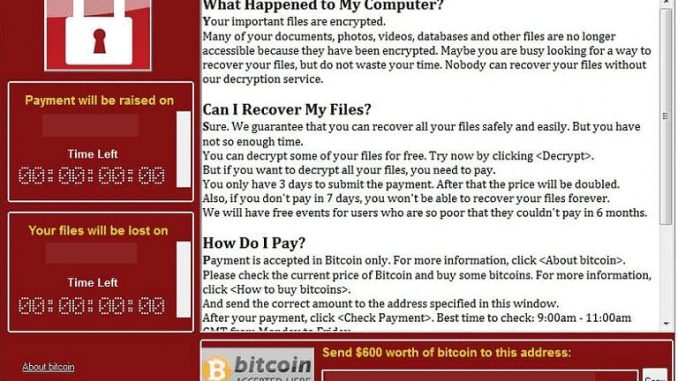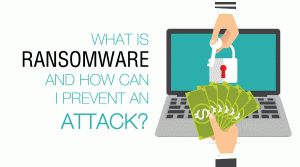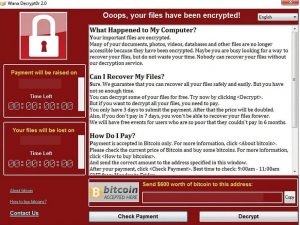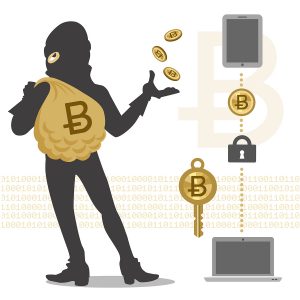
What’s WannaCry and how does ransomware work?
A world-wide cyber attack has been underway since Friday, impacting more than 200,000 organisations in 150 nations. In britain, the leading assault strike 47 NHS trusts, resulting in operations being cancelled and patients turned away from A&E.  The “WannaCry” ransomware seems to have used a defect in Microsoft’s applications, found by the National Security Agency and leaked by hackers, to disperse quickly across networks locking away files.
The “WannaCry” ransomware seems to have used a defect in Microsoft’s applications, found by the National Security Agency and leaked by hackers, to disperse quickly across networks locking away files.
A security specialist was able to stop the assault by activating a “kill switch” on Saturday but it’s continued to wreak havoc.
Ransomware, which demands payment after starting a cyber attack, has eventually become a growing tendency among hackers trying to find a fast payout.
What’s ransomware?

Ransomware is a form of cyber attack that calls for hackers taking control of a computer system and blocking access to it until a ransom is paid.
For cyber criminals to get access to the system they must download a form of malicious software on a device within the network. This really is done by getting a victim to click on a link or download it by error.
When the applications is on a victim’s computer the hackers can start an assault that locks in all files it can locate within a network. This will be a slow process with files being encrypted one after another.
Around Ransomware
- What’s ransomware? Malicious software that locks a device, like a computer, tablet PC or smartphone and then demands a ransom to unlock it.
- Where did ransomware originate? The very first recorded instance appeared in 2005 in America, but rapidly spread across the world.
- How can it change a computer? The applications is generally included inside an attachment to an e-mail that masquerades as something innocent. After opened it encrypts the hard disk, which makes it impossible to get or recover anything saved on there – such as photos, records or music.
- How will you be able to protect yourself? Anti virus software can shield your machine, although cybercriminals are always working on new methods to override such protection
- How much are casualties anticipated to pay? The ransom demanded changes. Casualties of a 2014 strike in the UK were charged £500. Nevertheless, there’s no promise that paying will get your information back
- Big firms with complex security systems have the ability to see this happening and may isolate records to minimise damage. People may not be quite as fortunate and may wind up losing access to all their advice.
- Cyber criminals frequently demand payment in return for unlocking the files. This really is usually in the type of bitcoin, the on-line cryptocurrency.
What is Wanna Decryptor?
 Wanna Decryptor, also called WannaCry or Wcry, is a unique ransomware software which locks all the information on a computer system and leaves the user with just two files: directions on what to do next and the Wanna Decryptor application itself.
Wanna Decryptor, also called WannaCry or Wcry, is a unique ransomware software which locks all the information on a computer system and leaves the user with just two files: directions on what to do next and the Wanna Decryptor application itself.
When the application is opened it tells computer users that their files have been encryted, and allows them a day or two to pay up, warning which their files will otherwise be deleted. It demands payment in Bitcoin, gives directions on the best way to purchase it, and offers a Bitcoin address to send it to.
Most computer security firms have ransomware decryption programs that could circumvent the program.
It was utilized in a major cyber attack that changed organisations around the planet including the NHS and Telefonica in Spain.
A youthful cyber specialist was able to stop the spread of the strike by inadvertently activating a “kill switch” when he purchased a net domain name for less than £10.
When the WannaCry software infects a fresh computer it contacts the internet address. It’s programmed to terminate itself if it manages to get through. When the 22-year old research worker purchased the domain name the ransomware could connect and was so quit. .
The best way to safeguard yourself against ransomware strikes.
The most effective protection against ransomware strikes will be to have all files backed up in an entirely different system. What this means is that in the event you suffer an assault you will not lost any advice to the hackers.
It’s tough to prevent motivated hackers from starting a ransomware strike, but exercising care can help. Cyber attackers have to download the malicious software on a computer, cellphone or another connected device.
The most frequent ways of installing the virus are through endangered e-mails and sites.
As an example, hackers could send an employee a phishing e-mail that appears that it comes from their supervisor requesting them to open a link. But it really links to a malicious web site that surreptitiously downloads the virus onto their computer.
Downloading a poor application or app, and seeing a web site that’s showing malicious adverts may also lead to an infected apparatus.
The finest means to guard yourself is to be leery of unsolicited e-mails and consistently type out internet addresses yourself rather than clicking on links. Another crucial defence is antivirus software that could scan files before they may be downloaded, block secret installments and try to find malware that could already be on a computer.
Cyber security firms have developed innovative defences against the cyber attack, including machines that fight back when they see hackers in a method.
What to do if you’re a victim – should you pay the ransom?
Sufferers are informed t o never pay the ransom as it supports the attackers. Even if casualties do pay there is, in addition, no guarantee that all files will soon be returned to them in tact. Rather, the best thing to do is restore all files from a back up. If that is really not possible, there are some tools that can decrypt and regain some info.
o never pay the ransom as it supports the attackers. Even if casualties do pay there is, in addition, no guarantee that all files will soon be returned to them in tact. Rather, the best thing to do is restore all files from a back up. If that is really not possible, there are some tools that can decrypt and regain some info.
How much do hackers demand, and why in Bitcoin?
Ransomware frequently requires between 0.3 and 1 Bitcoins (£400 – 1,375), but can require a payment denominated in dollars but made via Bitcoin. The electronic money is popular with cybercriminals as it’s decentralised, unregulated and almost impossible to follow. Even though it might appear like a modest quantity to charge, the ransomware strikes in many cases are widely dispersed, or so the ransom payments can stack up.